2010 LINCOLN TOWN CAR octane
[x] Cancel search: octanePage 253 of 285
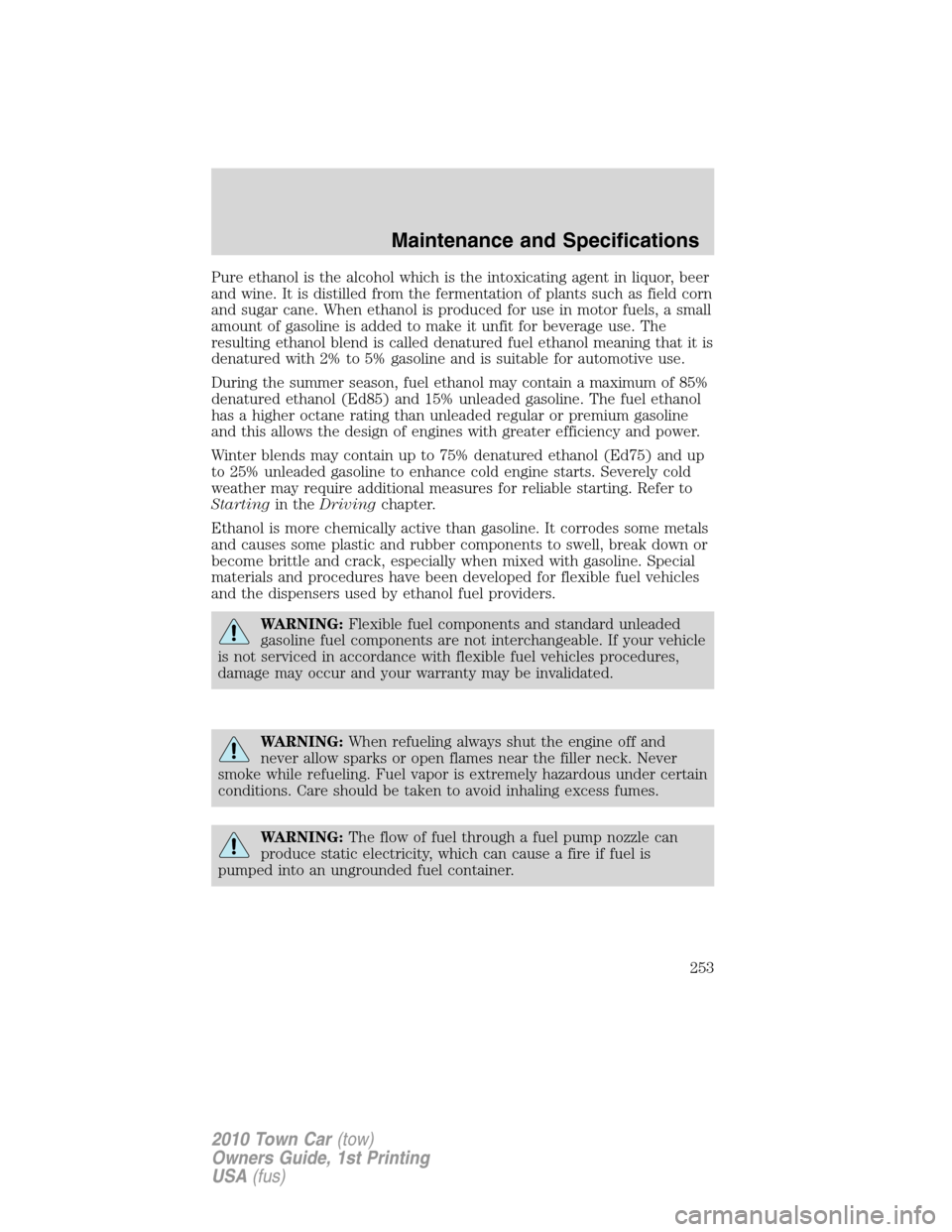
Pure ethanol is the alcohol which is the intoxicating agent in liquor, beer
and wine. It is distilled from the fermentation of plants such as field corn
and sugar cane. When ethanol is produced for use in motor fuels, a small
amount of gasoline is added to make it unfit for beverage use. The
resulting ethanol blend is called denatured fuel ethanol meaning that it is
denatured with 2% to 5% gasoline and is suitable for automotive use.
During the summer season, fuel ethanol may contain a maximum of 85%
denatured ethanol (Ed85) and 15% unleaded gasoline. The fuel ethanol
has a higher octane rating than unleaded regular or premium gasoline
and this allows the design of engines with greater efficiency and power.
Winter blends may contain up to 75% denatured ethanol (Ed75) and up
to 25% unleaded gasoline to enhance cold engine starts. Severely cold
weather may require additional measures for reliable starting. Refer to
Startingin theDrivingchapter.
Ethanol is more chemically active than gasoline. It corrodes some metals
and causes some plastic and rubber components to swell, break down or
become brittle and crack, especially when mixed with gasoline. Special
materials and procedures have been developed for flexible fuel vehicles
and the dispensers used by ethanol fuel providers.
WARNING:Flexible fuel components and standard unleaded
gasoline fuel components are not interchangeable. If your vehicle
is not serviced in accordance with flexible fuel vehicles procedures,
damage may occur and your warranty may be invalidated.
WARNING:When refueling always shut the engine off and
never allow sparks or open flames near the filler neck. Never
smoke while refueling. Fuel vapor is extremely hazardous under certain
conditions. Care should be taken to avoid inhaling excess fumes.
WARNING:The flow of fuel through a fuel pump nozzle can
produce static electricity, which can cause a fire if fuel is
pumped into an ungrounded fuel container.
Maintenance and Specifications
253
2010 Town Car(tow)
Owners Guide, 1st Printing
USA(fus)
Page 256 of 285
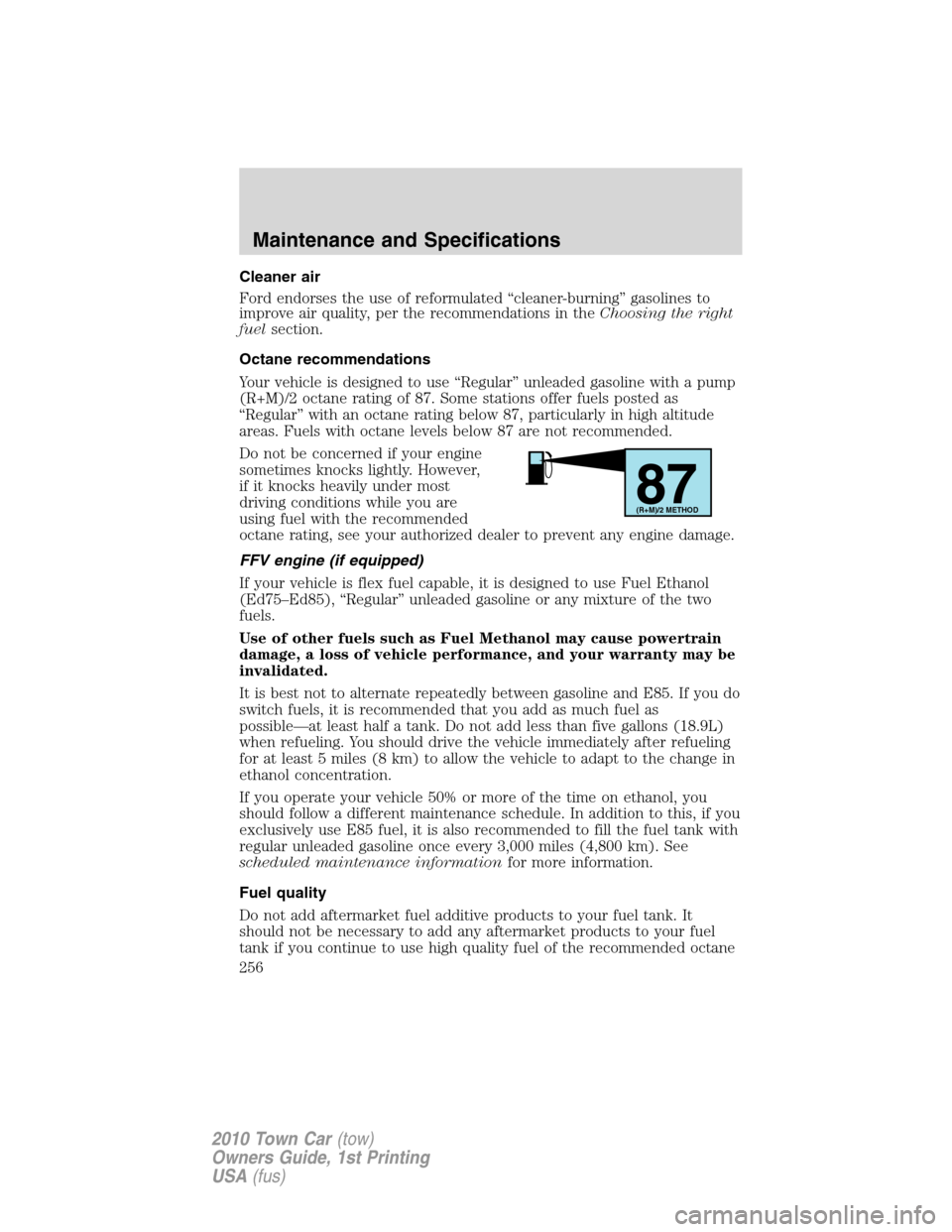
Cleaner air
Ford endorses the use of reformulated “cleaner-burning” gasolines to
improve air quality, per the recommendations in theChoosing the right
fuelsection.
Octane recommendations
Your vehicle is designed to use “Regular” unleaded gasoline with a pump
(R+M)/2 octane rating of 87. Some stations offer fuels posted as
“Regular” with an octane rating below 87, particularly in high altitude
areas. Fuels with octane levels below 87 are not recommended.
Do not be concerned if your engine
sometimes knocks lightly. However,
if it knocks heavily under most
driving conditions while you are
using fuel with the recommended
octane rating, see your authorized dealer to prevent any engine damage.
FFV engine (if equipped)
If your vehicle is flex fuel capable, it is designed to use Fuel Ethanol
(Ed75–Ed85), “Regular” unleaded gasoline or any mixture of the two
fuels.
Use of other fuels such as Fuel Methanol may cause powertrain
damage, a loss of vehicle performance, and your warranty may be
invalidated.
It is best not to alternate repeatedly between gasoline and E85. If you do
switch fuels, it is recommended that you add as much fuel as
possible—at least half a tank. Do not add less than five gallons (18.9L)
when refueling. You should drive the vehicle immediately after refueling
for at least 5 miles (8 km) to allow the vehicle to adapt to the change in
ethanol concentration.
If you operate your vehicle 50% or more of the time on ethanol, you
should follow a different maintenance schedule. In addition to this, if you
exclusively use E85 fuel, it is also recommended to fill the fuel tank with
regular unleaded gasoline once every 3,000 miles (4,800 km). See
scheduled maintenance informationfor more information.
Fuel quality
Do not add aftermarket fuel additive products to your fuel tank. It
should not be necessary to add any aftermarket products to your fuel
tank if you continue to use high quality fuel of the recommended octane
87(R+M)/2 METHOD
Maintenance and Specifications
256
2010 Town Car(tow)
Owners Guide, 1st Printing
USA(fus)
Page 258 of 285
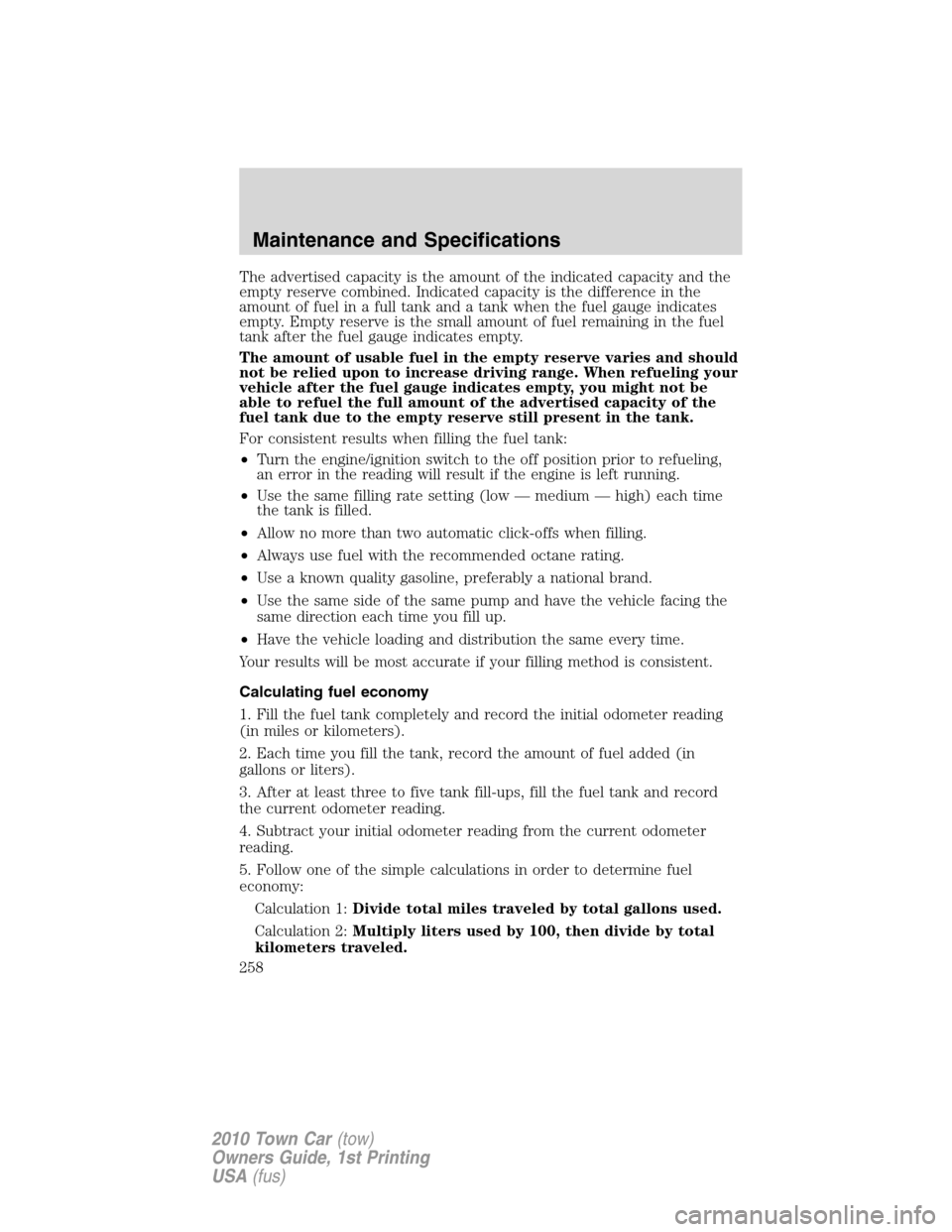
The advertised capacity is the amount of the indicated capacity and the
empty reserve combined. Indicated capacity is the difference in the
amount of fuel in a full tank and a tank when the fuel gauge indicates
empty. Empty reserve is the small amount of fuel remaining in the fuel
tank after the fuel gauge indicates empty.
The amount of usable fuel in the empty reserve varies and should
not be relied upon to increase driving range. When refueling your
vehicle after the fuel gauge indicates empty, you might not be
able to refuel the full amount of the advertised capacity of the
fuel tank due to the empty reserve still present in the tank.
For consistent results when filling the fuel tank:
•Turn the engine/ignition switch to the off position prior to refueling,
an error in the reading will result if the engine is left running.
•Use the same filling rate setting (low — medium — high) each time
the tank is filled.
•Allow no more than two automatic click-offs when filling.
•Always use fuel with the recommended octane rating.
•Use a known quality gasoline, preferably a national brand.
•Use the same side of the same pump and have the vehicle facing the
same direction each time you fill up.
•Have the vehicle loading and distribution the same every time.
Your results will be most accurate if your filling method is consistent.
Calculating fuel economy
1. Fill the fuel tank completely and record the initial odometer reading
(in miles or kilometers).
2. Each time you fill the tank, record the amount of fuel added (in
gallons or liters).
3. After at least three to five tank fill-ups, fill the fuel tank and record
the current odometer reading.
4. Subtract your initial odometer reading from the current odometer
reading.
5. Follow one of the simple calculations in order to determine fuel
economy:
Calculation 1:Divide total miles traveled by total gallons used.
Calculation 2:Multiply liters used by 100, then divide by total
kilometers traveled.
Maintenance and Specifications
258
2010 Town Car(tow)
Owners Guide, 1st Printing
USA(fus)
Page 272 of 285
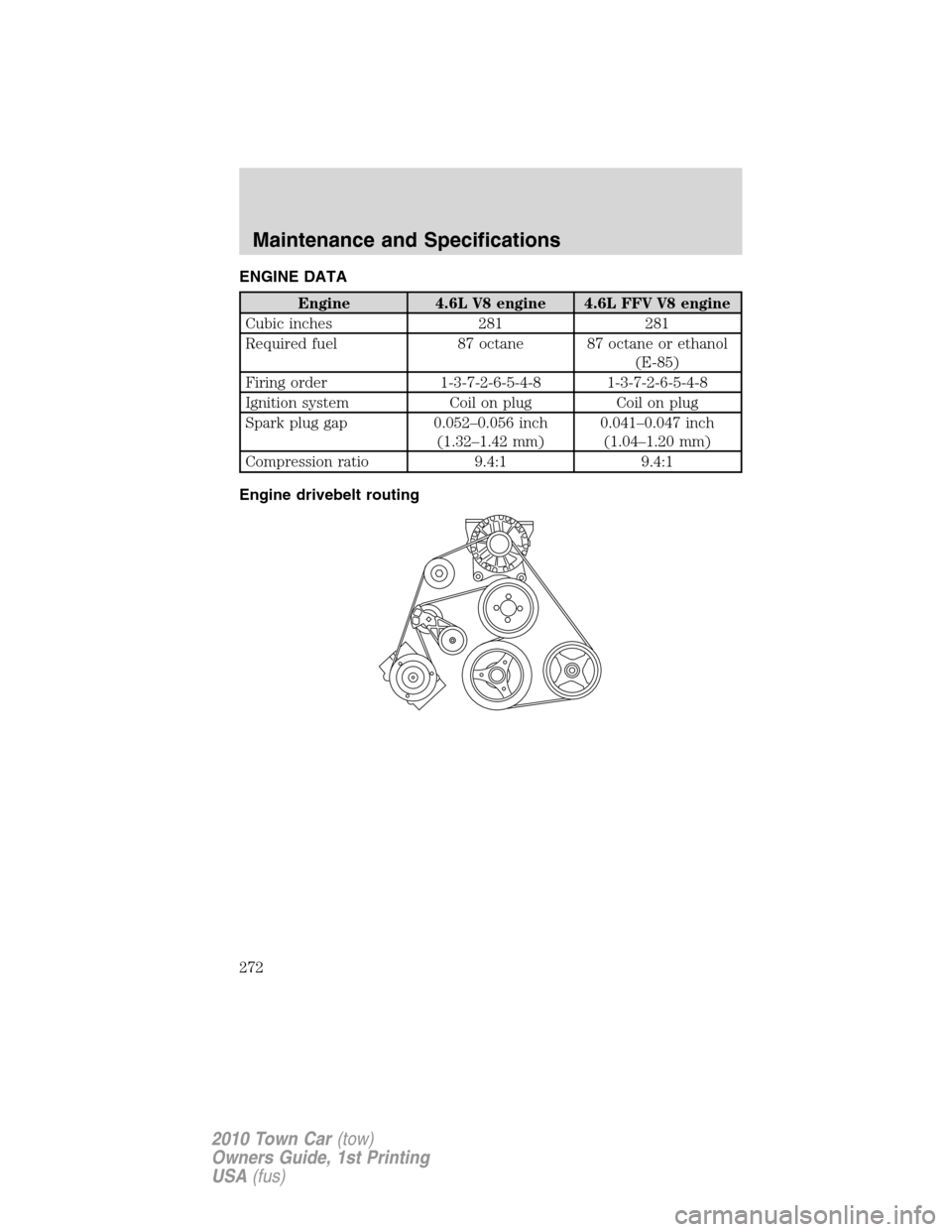
ENGINE DATA
Engine 4.6L V8 engine 4.6L FFV V8 engine
Cubic inches 281 281
Required fuel 87 octane 87 octane or ethanol
(E-85)
Firing order 1-3-7-2-6-5-4-8 1-3-7-2-6-5-4-8
Ignition system Coil on plug Coil on plug
Spark plug gap 0.052–0.056 inch
(1.32–1.42 mm)0.041–0.047 inch
(1.04–1.20 mm)
Compression ratio 9.4:1 9.4:1
Engine drivebelt routing
Maintenance and Specifications
272
2010 Town Car(tow)
Owners Guide, 1st Printing
USA(fus)
Page 282 of 285
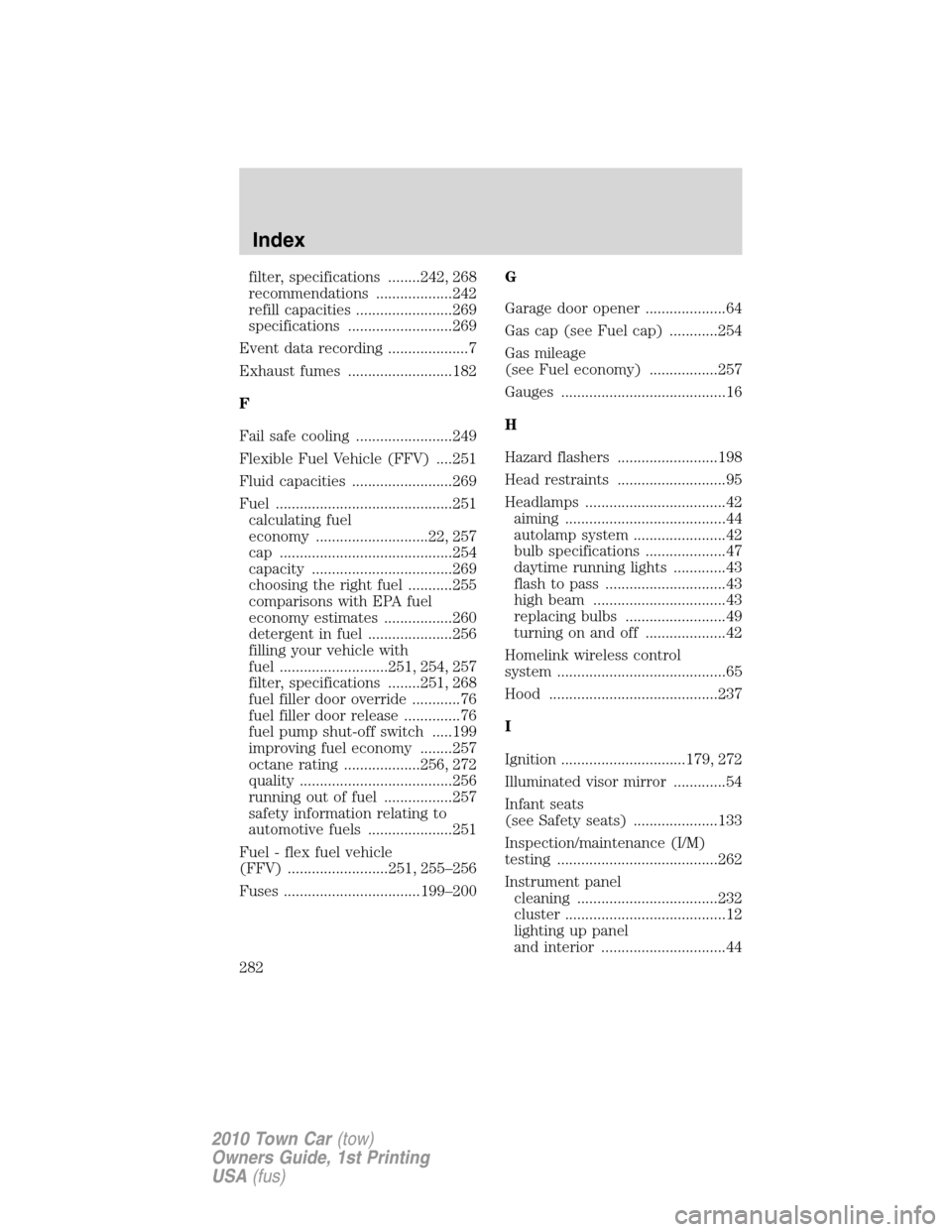
filter, specifications ........242, 268
recommendations ...................242
refill capacities ........................269
specifications ..........................269
Event data recording ....................7
Exhaust fumes ..........................182
F
Fail safe cooling ........................249
Flexible Fuel Vehicle (FFV) ....251
Fluid capacities .........................269
Fuel ............................................251
calculating fuel
economy ............................22, 257
cap ...........................................254
capacity ...................................269
choosing the right fuel ...........255
comparisons with EPA fuel
economy estimates .................260
detergent in fuel .....................256
filling your vehicle with
fuel ...........................251, 254, 257
filter, specifications ........251, 268
fuel filler door override ............76
fuel filler door release ..............76
fuel pump shut-off switch .....199
improving fuel economy ........257
octane rating ...................256, 272
quality ......................................256
running out of fuel .................257
safety information relating to
automotive fuels .....................251
Fuel - flex fuel vehicle
(FFV) .........................251, 255–256
Fuses ..................................199–200G
Garage door opener ....................64
Gas cap (see Fuel cap) ............254
Gas mileage
(see Fuel economy) .................257
Gauges .........................................16
H
Hazard flashers .........................198
Head restraints ...........................95
Headlamps ...................................42
aiming ........................................44
autolamp system .......................42
bulb specifications ....................47
daytime running lights .............43
flash to pass ..............................43
high beam .................................43
replacing bulbs .........................49
turning on and off ....................42
Homelink wireless control
system ..........................................65
Hood ..........................................237
I
Ignition ...............................179, 272
Illuminated visor mirror .............54
Infant seats
(see Safety seats) .....................133
Inspection/maintenance (I/M)
testing ........................................262
Instrument panel
cleaning ...................................232
cluster ........................................12
lighting up panel
and interior ...............................44
Index
282
2010 Town Car(tow)
Owners Guide, 1st Printing
USA(fus)
Page 283 of 285
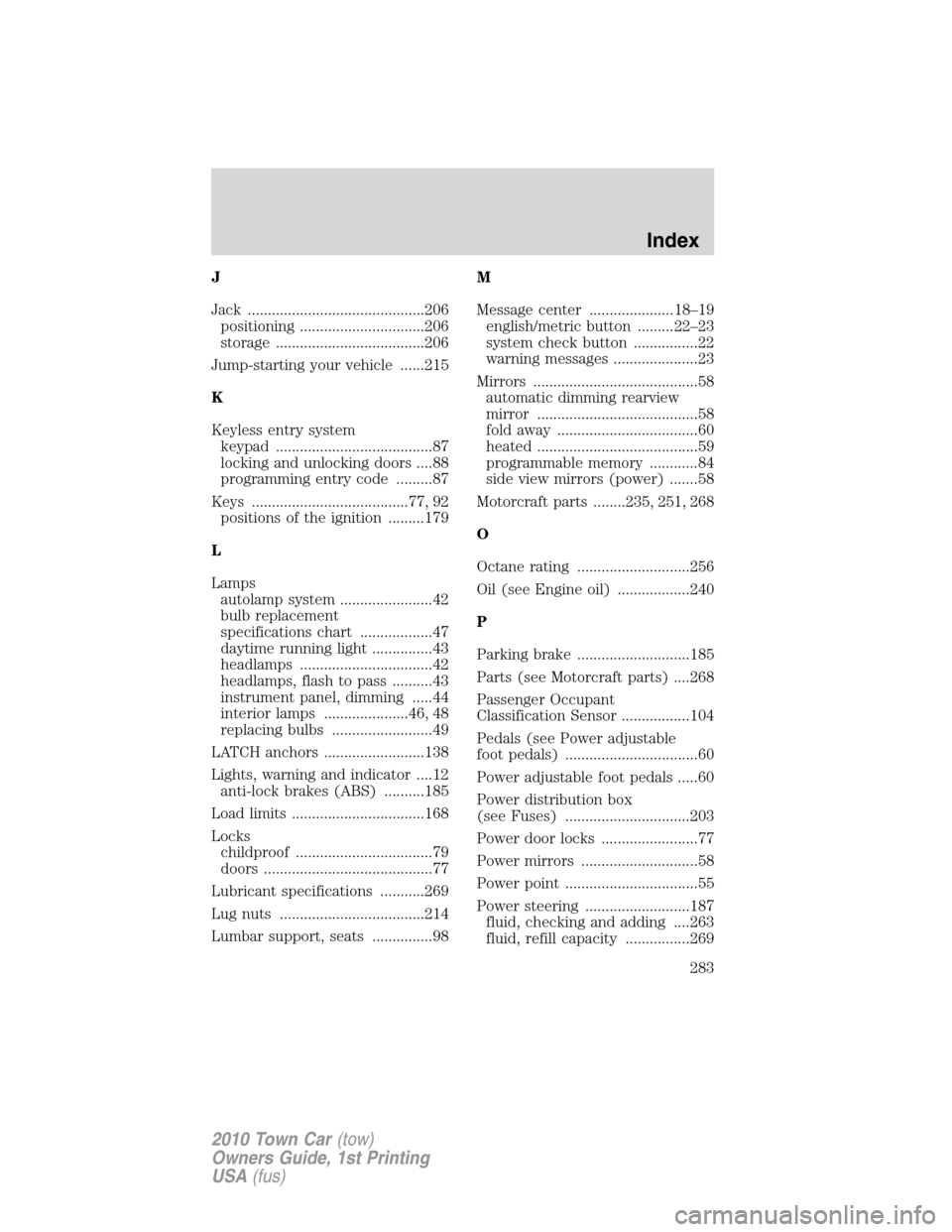
J
Jack ............................................206
positioning ...............................206
storage .....................................206
Jump-starting your vehicle ......215
K
Keyless entry system
keypad .......................................87
locking and unlocking doors ....88
programming entry code .........87
Keys .......................................77, 92
positions of the ignition .........179
L
Lamps
autolamp system .......................42
bulb replacement
specifications chart ..................47
daytime running light ...............43
headlamps .................................42
headlamps, flash to pass ..........43
instrument panel, dimming .....44
interior lamps .....................46, 48
replacing bulbs .........................49
LATCH anchors .........................138
Lights, warning and indicator ....12
anti-lock brakes (ABS) ..........185
Load limits .................................168
Locks
childproof ..................................79
doors ..........................................77
Lubricant specifications ...........269
Lug nuts ....................................214
Lumbar support, seats ...............98M
Message center .....................18–19
english/metric button .........22–23
system check button ................22
warning messages .....................23
Mirrors .........................................58
automatic dimming rearview
mirror ........................................58
fold away ...................................60
heated ........................................59
programmable memory ............84
side view mirrors (power) .......58
Motorcraft parts ........235, 251, 268
O
Octane rating ............................256
Oil (see Engine oil) ..................240
P
Parking brake ............................185
Parts (see Motorcraft parts) ....268
Passenger Occupant
Classification Sensor .................104
Pedals (see Power adjustable
foot pedals) .................................60
Power adjustable foot pedals .....60
Power distribution box
(see Fuses) ...............................203
Power door locks ........................77
Power mirrors .............................58
Power point .................................55
Power steering ..........................187
fluid, checking and adding ....263
fluid, refill capacity ................269
Index
283
2010 Town Car(tow)
Owners Guide, 1st Printing
USA(fus)